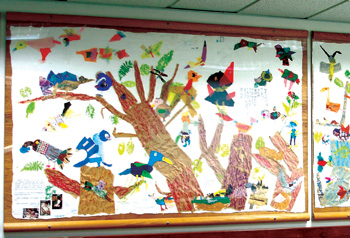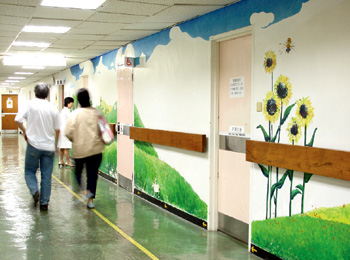Culture and Leisure
Other Stories

At This Moment exhibition is now being held
in the Pamela Youde Nethersole Eastern Hospital.
Ge Yuwei
Healing with art
by Ge Yuwei
Art is getting into Hong Kong hospitals to enliven gloomy patients surrounded by uni-coloured walls, a smell of bleach and the coldness in the medical institutions.
Ex-mental patient Law Hoi-hung said it was much by virtue of art, rather than conventional treatment, that he recovered.
“Painting relieves me from pressures. In the process of painting, I will not think too much,” he said.
Law began oil painting after joining the New Life Psychiatric Rehabilitation Association.
Lau Chung-yim, a creative arts lecturer at the Hong Kong Institute of Education, said art could help improve patients' generic skills such as cooperation, logic, communication and creativity, and could engage their emotions and desires.
“It (art) could shift away patients' attention from illness and therefore change their emotions,” said Lau, who used to be an art therapy laboratory researcher at the La Trobe University in Australia.
Utilising art and art therapy in hospitals has a long history in western countries.
However, Lau is “pessimistic” towards its development and prospect in Hong Kong. “Art therapy could not stand out as an independent form of treatment (in Hong Kong),” he said.
Yet, some artists are pioneering the concept of hospital gallery to cheer up patients with various art activities.
For example, a photo exhibition titled At This Moment is now being held in the Pamela Youde Nethersole Eastern Hospital until January 15.
Photographer Mary Mar Lai-wa said art could bring a healing effect “through removing the sadness in patients' hearts”, and strengthen them with “a desire to recover”. Considering patients' limited access to the outside world, Mar chose photos of nature for her exhibition.
“I hope to relieve the patients' anxiety and bring a light, open and hopeful heart to them,” Mar said.
This exhibition was promoted and coordinated by Art in Hospital, a registered charitable organisation in Hong Kong.
The group was founded by two local artists, Oscar Ho Hing-kay and Evelyna Liang Kan Yee-woo, with an aim to promote art in hospitals.
The pair separately experienced the feeling of loneliness and helplessness when they were hospitalised.
They decided to bring warmth to hospitals by beautifying the environment after they recovered.
Sharing the common ideal, Ho and Liang established Art in Hospital after a project of wall painting in the radiotherapy unit at the Prince of Wales Hospital in 1994.
“I think the paintings are very beautiful. With those murals, I will not be bored here,” patient Lee Kam-tin said in the corridor, staring at the murals painted 11 years ago whereas still brilliant.
So Wai-ying, a project coordinator of Art in Hospital, said her group was the only organisation promoting hospital art in Hong Kong.
Their promotion work depended largely on mural paintings at the beginning.
“Sometimes we invited artists to do the murals. Sometimes we invited patients in a hospital to participate in colouring the paintings if possible,” So said.
Her colleague Tung Mei-chi said that hospitals were just “barren” without mural paintings.
Art in Hospital has so far created almost 100 mural paintings in nearly 40 hospitals in Hong Kong.
Tung once worked with a patient in a painting programme at a sanatorium to design and paint a big mural that was eight feet wide and nine feet high.
The patient, who is a permanent resident in the sanatorium, has leg spasm and is wheelchair-bound.
Tung said the patient had to finish the upper part of the mural with the help of volunteers, as he could not paint on his own.
“Painting the mural was then like decorating his home. And the mural brought home feeling and warmth to the sanatorium,” she said.
Patients' participation not only contributes to the improvement of environment, but also increases their confidence.
“In this way, Art in Hospital was helping the patient fulfil his dream and develop his potential,” Tung said.
Other forms of art promotion have been introduced into hospitals as the group developed, such as art workshops, storytelling programmes and hospital galleries.
Storytelling is designed to meet children's need.
Tung said: “Children in the wards need great care during treatment and recovery, and storytelling is a good way (to show the care).”
The organisation invites artists to create some storybooks, and among the authors is a seven-year-old child.
Tung considers his storybooks are encouraging, such as Pain, Pain, Fly Away , a story about how a child relieves himself from pain.
“Children's painting is naive, close to children, and thus understandable to children,” she said.
With permissions from hospitals, volunteers who are trained in storytelling can enter the wards to tell bedside stories to children patients.
“We hope that through storytelling, children will forget about the pain in the treatment and meanwhile become inspired to fight against the illness,” Tung said.
A more interactive programme offered by the organisation is art workshops. Tung said it was to provide a chance for patients to practise art in hospital.
“More ideas and thoughts will come into patients' minds, and this renders more communication between the patients and the outside world,” she said.
She considers art workshops are good for patients to “discover and develop their skills”, which, in turn, give them self-confidence.
Although there are different forms of promotion, they will collect information of the site and find out the patients' needs before carrying out every project, Tung said.
Based on the information, Art in Hospital then sets a theme for the project and discuss it with the hospital.
“At last, we look for artists whose styles match the theme, and then carry out the project, together with our volunteers,” Tung said.
Local hospitals are, in fact, also trying to use art to assist medical treatment.
“Although we have no art therapist in our hospital, we are still trying to use art to help the patients,” said Yu Kin-wa, a medical worker at the patient resource centre of the Queen Elizabeth Hospital.
She pointed out that of the few qualified art therapists in Hong Kong, most were foreigners. “There will be communication difficulties between the therapists and patients,” Yu said.
A lack of qualified art therapists limits the use of art in hospitals, she added.
But Yu sees great potential for applying artistic means to support patients. “We are still at the beginning stage. I hope more medical workers can recognise the function of art in treatments.”

The paper cutting gallery in the Prince of Wales Hospital is one of the first programmes of Art in Hospital.
Ge Yuwei

Mural paintings in the Prince of Wales Hospital make patients feel relaxed.
Ge Yuwei